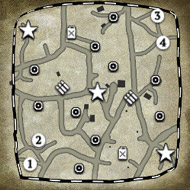Panzerkampfwagen 6 "Tiger"  axis
axis
As my vacation starts today and I feel like being generous (

) i present you my favourite tank, the Tiger 1! Never having seen any WW2 tank before, the Tiger was a simple beauty made out of steel. No sloped armour, just massive, angular steel.
Production: 1942-1944
Number Built: 1,349
Crew: 5
Weight: 55 t
Engine Ouput: 700 hp
Speed on Roads: 38 km/h
Armament: 88 mm KwK 36 L/56 gun
2x7,92 mm machine guns
The Tiger has always been steeped in myth and legend.
The Tiger is the most famous tank of World War 2. Even though it was not until 1942 that it was first used in action, its roots can be traced back to the 1930s. For that reason, the Tiger's design is quite conservative and does not yet incorporate sloping armour. It is the same characteristic German tank design that was also used for Panzers 3 and 4.

(This massive piece of steel was absolutely impressive. Definitely my favourite tank by appearance!)
The Tiger's armour and firepower were increased to the extreme. Tremendously thick armour was combined with and extremely effective and accurate gun. In order to realise such a system, farreaching technical solutions for the tank's interior had to be found.
So even though its design was not extraordinary, the Tiger was a technically sophisicated state-of-the-art tank. It was, for that reason, a very expensive vehicle that had never been intended for mass production. Its limited range and proneness to technical failures were a permanent source of problems.


The war situation prevented the Tiger from ever playing its originally intended role as a "Durchbruchwagen" (breakthrough vehicle). Rather, the Tigers had to serve as battle tanks at all the front's hot spots, where they were entirely destroyed or lost. But even though individual Tigers proved to be formidable and achieved high kill rates, their overall limited number prevented them from having a real impact on the war.
The "Tiger myth" was already created during the war. Its distinctive form, the high combat power, the propaganda - all this resulted in both sides glorifying the Tiger as being invincible; while the war was still going on, and even more so when it was over.

(T34/76 shot right above the track, didn't fully penetrate.)











 ) i present you my favourite tank, the Tiger 1! Never having seen any WW2 tank before, the Tiger was a simple beauty made out of steel. No sloped armour, just massive, angular steel.
) i present you my favourite tank, the Tiger 1! Never having seen any WW2 tank before, the Tiger was a simple beauty made out of steel. No sloped armour, just massive, angular steel. 








































 cblanco ★
cblanco ★  보드카 중대
보드카 중대  VonManteuffel
VonManteuffel  Heartless Jäger
Heartless Jäger 